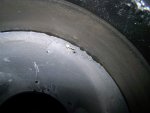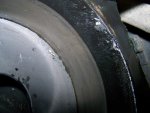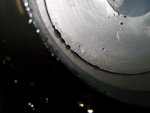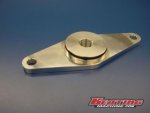- 574
- 653
- 93
- Location
- East Central Oklahoma
So I started getting antifreeze in my oil. Here's the thread on that: http://www.steelsoldiers.com/showth...-Small-amount-of-antifreeze-in-oil&highlight=
I finally got time to start working on it, and got the rear head pulled today. I should have the front one off tomorrow. It has the old style tabbed head gaskets on it. I haven't found a definite source for the antifreeze leak, but I did find another issue...
It appears the rear piston is slightly melted along the rear edge, and there's a few pits on the face. There's a bit of melted aluminum spatter on the face of the piston along the rear edge, and a bit on the liner above that, above where the piston rides. The portion of the liner I can see, and the face of the head/valves don't appear to have any damage.
The exhaust port of that cylinder has a lot of oil residue/sludge in it, and a portion of the exhaust manifold gasket was missing which blew oil down the side of the block. I'm guessing there's oil leaking into the exhaust port from around the valve, so I'll have to work on that.
Could these two things be related?
I'm the 4th person on Steel Soldiers to own this truck. The first owner (BFR) installed a pyro pre-turbo, so hopefully the EGTs haven't been too high since then. The highest I've had the EGTs is 1,200 degrees one time for less than a minute. So it's possible that piston has been like that for 8-10 years, through 4 owners, and ??? miles/hours...
So do y'all think this piston is bad enough that it NEEDS to be replaced? If it's been like that all this time, and the liner is fine, I'm hoping I don't have to replace it. If not, could I just swap in one good used take-out piston? Anyone else encounter this before, and what did you do?



Thanks!
I finally got time to start working on it, and got the rear head pulled today. I should have the front one off tomorrow. It has the old style tabbed head gaskets on it. I haven't found a definite source for the antifreeze leak, but I did find another issue...
It appears the rear piston is slightly melted along the rear edge, and there's a few pits on the face. There's a bit of melted aluminum spatter on the face of the piston along the rear edge, and a bit on the liner above that, above where the piston rides. The portion of the liner I can see, and the face of the head/valves don't appear to have any damage.
The exhaust port of that cylinder has a lot of oil residue/sludge in it, and a portion of the exhaust manifold gasket was missing which blew oil down the side of the block. I'm guessing there's oil leaking into the exhaust port from around the valve, so I'll have to work on that.
Could these two things be related?
I'm the 4th person on Steel Soldiers to own this truck. The first owner (BFR) installed a pyro pre-turbo, so hopefully the EGTs haven't been too high since then. The highest I've had the EGTs is 1,200 degrees one time for less than a minute. So it's possible that piston has been like that for 8-10 years, through 4 owners, and ??? miles/hours...
So do y'all think this piston is bad enough that it NEEDS to be replaced? If it's been like that all this time, and the liner is fine, I'm hoping I don't have to replace it. If not, could I just swap in one good used take-out piston? Anyone else encounter this before, and what did you do?



Thanks!



